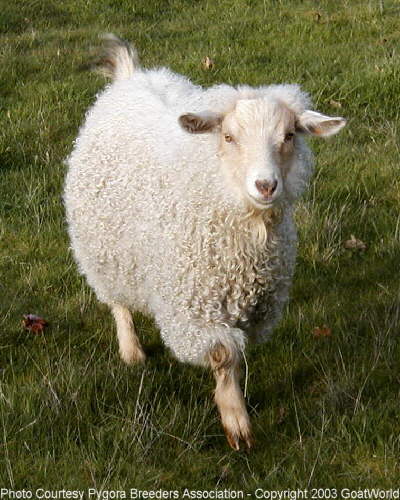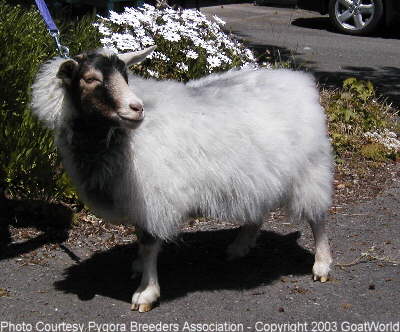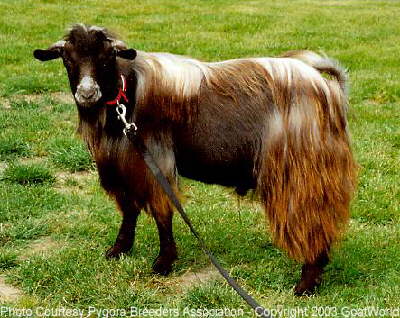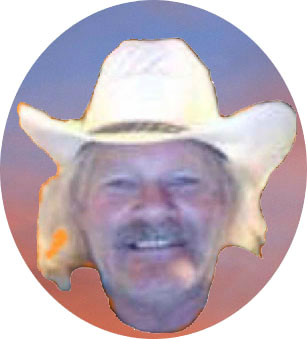Beauty More Than Skin Deep
The Pygora is first and foremost a fiber-producing animal; however, conformation is not to be ignored. All Pygoras must remain functional, healthy animals, well able to forage and reproduce with minimal human intervention. Their conformation needs to reflect these qualities.
Breed Standards, creating the Pygora as a cross between an American Angora Goat Breeders Association (AAGBA) Angora and a National Pygmy Goat Association (NPGA) Pygmy were developed in 1990. These Standards specify that Angora/Pygmy mixtures may contain up to, but not more than, 75% of one of the parent breeds. A minimum height requirement of 18 inches for does and 23 inches for bucks is required. There is no maximum height restriction. Most kids weigh about 5 pounds at birth. Does range in weight from 65-75 pounds, while bucks and wethers range from 75-95 pounds.
Breed Standards permit goats with or without horns. The majority of Pygora breeders do disbud their animals at an early age for their own convenience (keeps animals from getting hung up in feeders and fences, for example) or to provide a safer animal for youngsters. Whether or not to disbud is a personal preference or decision.
 `
All Pygmy colors and their dilutions plus white are acceptable. Color markings resembling other breeds do not meet Pygora breed standards.
`
All Pygmy colors and their dilutions plus white are acceptable. Color markings resembling other breeds do not meet Pygora breed standards.
Coats of Many Colors-and Kinds
Pygoras have inherited the best fiber characteristics of both the Angora goat that produces mohair and a Pygmy that produces a very fine down. They grow a fleece that can take on many qualities (depending on the fiber type), the fiber maintains its fineness as the animals ages, and-when spun-an exquisite yarn results. The fiber is very versatile in that it can be handspun; it can be knitted, crocheted or woven; it can be felted; or used to make wigs or beards, etc. on dolls.
Pygora goats produce three distinct types of fleece: type A, similar to the fleece of an Angora goat; type B, more like a blend of the angora fiber and the pygmy fiber; and type C, like cashmere. Between these types, there are variations and combinations-just as sheep often produce variations in fleece even within the same breed.
 Most Pygoras produce from 6 ounces to 2 pounds of fiber per shearing. Many type As or A/Bs are clipped two-or even three-times a year. True type A animals must be shorn or clipped. Types B and C will shed (blow) their fleeces in the spring if the fiber is not removed. Goats with B and C type fleeces may be shorn, combed, or plucked. All types will matt if left too long on the animal.
Most Pygoras produce from 6 ounces to 2 pounds of fiber per shearing. Many type As or A/Bs are clipped two-or even three-times a year. True type A animals must be shorn or clipped. Types B and C will shed (blow) their fleeces in the spring if the fiber is not removed. Goats with B and C type fleeces may be shorn, combed, or plucked. All types will matt if left too long on the animal.
Generally, with the exception of some A type fleeces, the Pygora goat produces guard hair and a down. In many cases, it is desirable to remove guard hairs from the down before spinning the fiber. The removal process may be done commercially or by hand. Dehairing by hand produces a wonderful, soft product but is time and labor-intensive. New and more accessible commercial dehairing equipment promises to make ready-to-spin Pygora fiber much more plentiful and available.
Pygora fiber takes color well and dyes ranging from Kool-aid to natural to commercial products produce a full range of fiber colors and shades. Equally exciting, on the other hand, are the colors found in the natural Pygora fiber itself. Most Pygora breeders find it is useful to keep a herd of both white and colored animals.
 The Pygora Breeders Association
The Pygora Breeders Association
In 1987, the Pygora Breeders Association (PBA) was begun with ten people who had been breeding Pygoras. By that time, there appeared to be consistency and quality to Pygoras. They seemed to be producing the same type of goat with each generation, and a different goat from the parent breeds of Angora and Pygmy. Wherever they were on display, Pygora goats generated strong interest. A Pygora registry was begun in 1987 and, since then, the Pygora herd book includes only Pygoras born of registered parents.
The Pygora Breeders Association is now firmly established and has over 100 members from across the US and Canada. It has By Laws, an elected Board with representation from all regions of the US, a quarterly newsletter, breeders and membership directories and a web site: https://www.pba-pygora.com. Sanctioned Pygora Shows with trained and certified judges are held throughout the year.
Compiled by:
Patricia Copa,
PBA Secretary
References:
Daurelle, Jude. Passion for Pygora: a survey of the fine fleece of pygora goats. Spin-off, Vol. 26, Number 2, Summer 2002.
Jorgensen, Katharine. The goat for all seasons/reasons. Fiberfest Magazine, Vol. 1, Issue 1, Fall 1993.
Pygora Breeders' Association. Judge's training manual. Lysander, NY. Rev. 9/06/02.
Pygora Breeders' Association. Questions and answers about the pygora goat. Undated.
Pygora Breeders' Association. Pygora goat fiber and its uses. The Goat Magazine, Vol. 6, Number 5, June/July 2002.
About the author:

|
About the author: Gary Pfalzbot is a Service Connected Disabled Veteran and the web master of GoatWorld as well as some other web sites. He has raised goats over the years, been involved with 4-H (as a young boy) and currently resides in Colorado where he and his wife Pam raise a few breeds of goats and other animals, and primarily author the GoatWorld web site to continue to inform, educate, and promote the industry.
|
|










